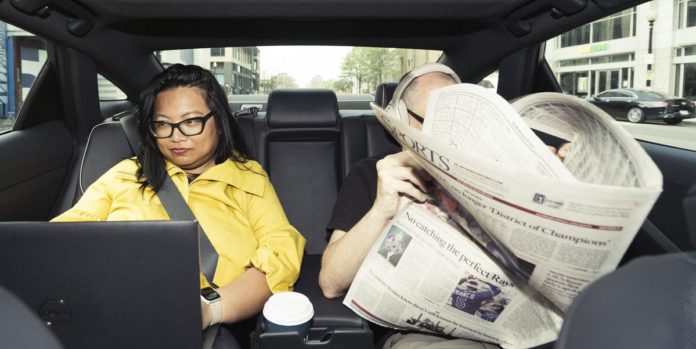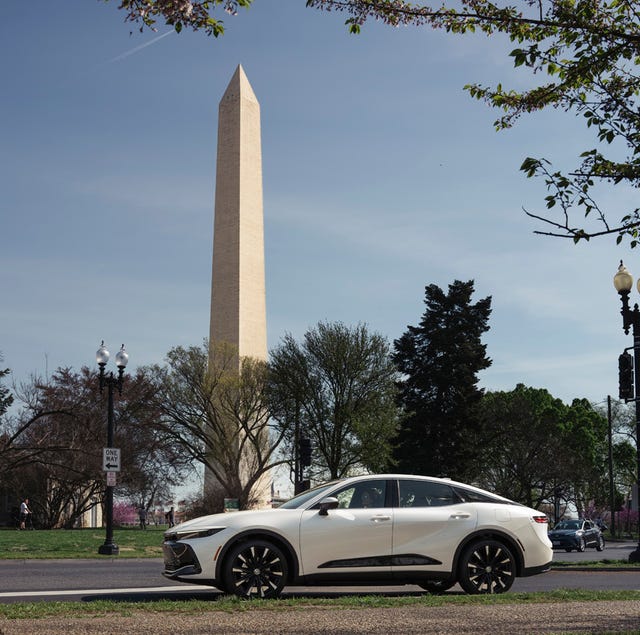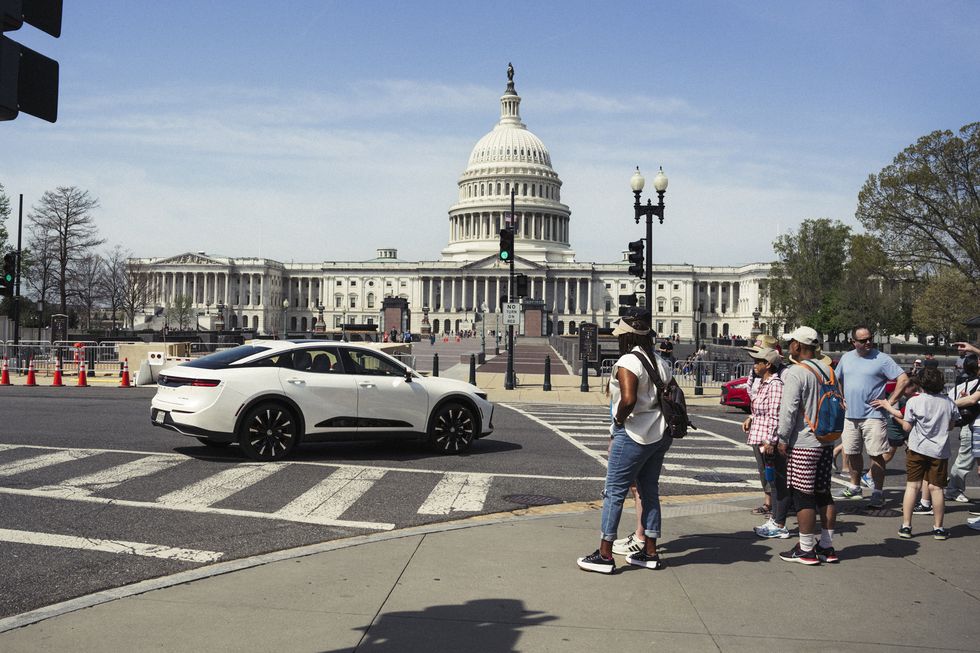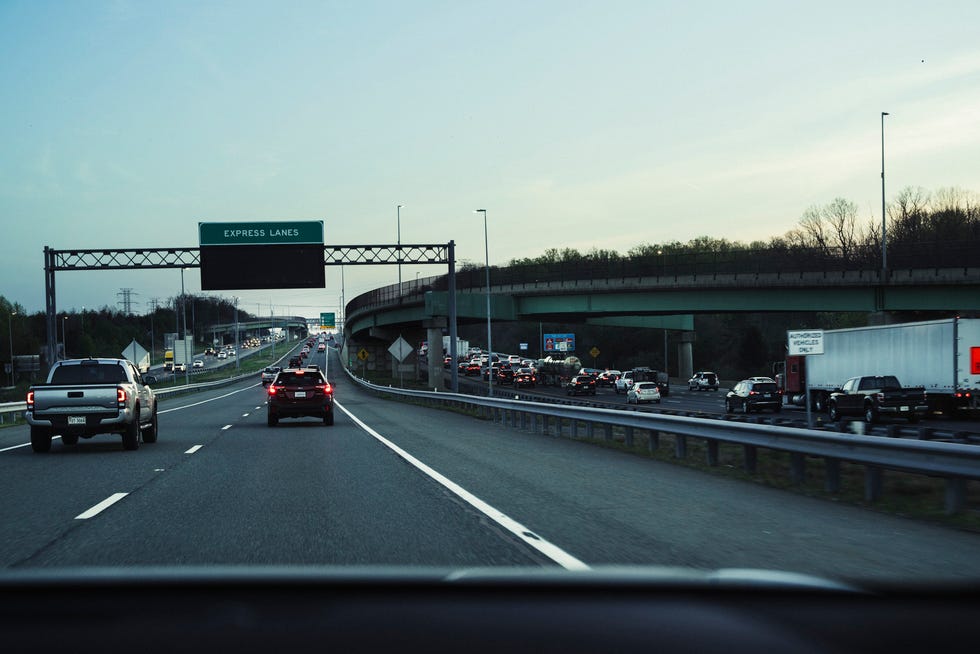From the June 2023 issue of Car and Driver.
Every city has its secrets. Washington, D.C., may have more than most, but I wasn’t there to dig up bodies, corporeal or political. My interest in visiting our nation’s capital was to find out more about a covert society, an organization of carpoolers who use codes and word of mouth to work around D.C.’s notorious traffic jams and exorbitant tolls. Under cherry blossoms light as dreams and in the long shadow of the Washington Monument, I set out in search of slugs.
The origins of slugging are murky, buried somewhere in the smoggy ’70s, when the Shirley Highway (I-395) from Virginia to D.C. became the first U.S. freeway to implement a high-occupancy vehicle (HOV) lane. Those early carpool lanes were strict, initially requiring four occupants (now three), so commuting drivers would fill their seats by swinging by the bus stop and sniping riders. Eventually, the bus lines had more hopeful carpoolers than mass-transit riders, and the bus drivers began referring to the faux passengers as false coins, also known as slugs. Undeterred by the slander, the slugs claimed the nickname and the practice grew in popularity, developing set locations and traditions. When the Virginia Department of Transportation partnered with the private toll-road operator Transurban in the early 2000s, multiperson vehicles were exempted from the expensive fees to encourage carpooling, thus keeping the fast lanes flowing free. Slugging is symbiotic—no money changes hands, but all parties benefit.
Had I set out to learn the secrets of the slugs a few years ago, it wouldn’t have been much of a challenge. According to the Metropolitan Washington Council of Governments’ 2019 State of the Commute report, 20 percent of all carpools were slugs. There were numerous pickup and drop-off spots and an active website detailing any route changes due to construction or traffic closures. Then the pandemic hit, and the slug lines were salted. In the 2022 report, only 4 percent of carpools were slugs, and my initial online research came up against abandoned forums, bounced-back emails, and 404 web links. The slugging community seemed to disappear overnight, the Roanoke Colony of the 21st century.
Nothing is as irresistible as a mystery, especially one with car culture at its center, and at Car and Driver, we couldn’t stop thinking about slugging. You just get in a stranger’s car? There’s no money? How? Why? I hopped a flight to D.C., picked up a pearl-white Toyota Crown with a back seat big enough for clandestine carpoolers, and set off in search of answers.
First stop, the Pentagon. With roughly 27,000 employees, large parking lots, and a Metrobus lane, the Pentagon was one of the early slugging destinations and one of the few active slug-line Facebook groups I was permitted to join. There are many slug-line Facebook groups, but many are, ahem, sluggish in posting or fiercely protective of their community. Most of my join requests and all my messages to admins went unanswered. The Pentagon seemed to still be slugging, with regular posts cryptically requesting riders for “234” or offering directions to “the Pork Chop.” I decided to check it out in hopes of decoding these secret messages.
For Drivers, D.C. Is No Los Angeles
What stood out to me as an Angeleno driving in D.C. was, first, the speed limits are low, and people mostly abide by them. Second, it’s a good thing they do because the roads are as tangled as a filibuster, with street names divided into quadrants, roundabouts that exit onto bridges, and constant construction. Even Google gave up, the map on the Crown’s center screen flickering in endless recalculation. It didn’t help that none of my slug-line pickup locations were hard addresses, just intersections pulled from screen-shots on the defunct Slug-Lines.com website. At this point, as I was parked next to a sign warning that my vehicle and person were subject to search, a police car pulled up next to me.
I explained to Officer Bush (it didn’t seem prudent to ask if he’s related to the former presidents) that I was not doing anything nefarious but was simply stupid, lost, and looking for the slug-line pickup. He pointed me to a parking lot one half-roundabout over. He hadn’t used slugs, he told me, but he knew people who had. “You can’t speak to anyone,” he said. “The riders just give the driver a token, and that’s how they know where to go.” This last bit proved a red herring, but the first part is true. I left the Pentagon with one piece of the puzzle. The slugs did exist.
My next lead came from one of the Facebook pages, a link to a WhatsApp group focused on trips between Horner and L’Enfant. I didn’t know what a Horner or a L’Enfant was, but I crossed my fingers and threw a message into the fray. “Hi, you can delete this, but I’m trying to learn more about slugging. Would anyone care to talk for a magazine story?” A few minutes later, my message was gone, “deleted by admin,” but not before I’d had a response, “You can call me tonight. —Jasmine,” and a phone number.
Get in Line
That afternoon, photographer Roy Ritchie and I went back to the Pentagon. Just before 4:00 p.m., office workers and military personnel started lining up along the curb of the parking lot Officer Bush had pointed out. A silver Lincoln Navigator pulled up, two waiting riders climbed in, and it pulled away. A blond woman walked toward a gray Tesla. She held up her fingers in quick succession, two-three-four. The driver nodded, and she got in the back seat. An older gentleman in a dark jacket joined her, and with its express-lane-friendly trio, the Tesla left. My initial attempts to converse with waiting slugs met with failure. The riders were sweaty and tired after walking from their offices, earbuds in, eager to leave. Drivers kept their windows up, avoiding eye contact as Ritchie and I skulked on the periphery. We felt like creeps. I had better luck when I changed my approach from journalist to rookie slug. “I want to do this tomorrow,” I told a woman in a lavender pantsuit. “Will people be upset if I’m new?”
“They only care about getting where they need to go,” she answered. She’d started slugging earlier this year, when a bus strike disrupted her regular commute. The man next to her was trying it for the first time on the advice of a friend. A hybrid Camry came to the curb, and they nodded to me and took off. By 4:30, the parking lot was sparse, but I felt confident we had enough info to try a slug ride the next morning. But first, I’d hear what Jasmine Smith had to say.
I don’t blame the Pentagon slugs for their reluctance to talk, but I sure appreciated Smith’s willingness. “Oh, I always like telling people about it because it’s such a strange concept,” she told me that evening. “Maybe somebody will get inspired, get it organized, and make an app.” Smith proved an excellent source, having slugged as both a rider and a driver soon after moving to the D.C. area in 2016. She acknowledged the scene’s weirdness, admitting that, at first, she couldn’t imagine anything that would convince her to get into a stranger’s car. “I rode the bus, which picked up at the same place as a slug line. Cars would drive up, people would get in, they’d drive off, and I thought, ‘Now these people are getting to work for free, and here I am standing in this bus line paying.'” Eventually, her curiosity won, and she gave it a try. “I got into the city, and I never stopped.” Slugging not only saves money but is better than standard carpooling because you’re never left high and dry due to someone else’s poor time management.
These days Smith drives, but she still uses slug lines. Without them, if she takes the faster-moving toll lanes, her commute costs nearly $60 a day, just in fees. Drivers farther out in Virginia might pay $40 or more each way without two passengers. Slugging makes a lot of sense. “Did anyone tell you the rules?” Smith asked before we ended the call. “No talking. No phone calls. No loud music.”
Life in the Slug Line
The next morning, rules in mind, we left D.C. while it was still dark. Our destination was the Route 234 park-and-ride lot, 30 miles outside of town. Not only did it satisfy my curiosity about the coded Facebook messages, but it also proved to be one of the busier afternoon Pentagon destinations, so I was hopeful we might score a morning pickup there.
Even at 6:00 a.m., the traffic coming into the city was daunting. Running down the center of I-95, the cars in the express lanes whizzed by, taunting those crawling on either side. It takes only one experience stuck in the D.C. jam to understand how an hour alone with your road rage can make a half-hour with a few polite strangers seem much more appealing. We pulled in near the bus stop, and there they were, in crisp work clothes, with papers under their arms, the waiting slugs. I opened the window and drove up. “Pentagon,” I said, trying to act mature and trustworthy, managing at best a nervous whisper-squeak. As two riders stepped forward, I added in a rush, “I’m writing a story about this just so you know, in case you don’t want to be part of it.” They shrugged and got in the back of the Crown. Just like that. No talk. The whole process took less than a minute.
The first few miles of the drive were eerily quiet, just the low hum of the Toyota’s powertrain, the slightest of shimmies as it tried to decide between gas and electric operation while we crept forward in stop-and-go, and the click of Ritchie’s camera. Once we got in the express lane, I broke the law. “We’re writing about the D.C. commute and slugging,” I said, waving at the camera in explanation. With permission granted, Ameeq Khan and Delane Aguilar became chatty, bemoaning the high cost of toll lanes and bus fares, peppering me with questions about the Crown, and celebrating the slow return of slugging post-COVID. Khan works at Georgetown University and has been slugging since 2006, often taking a ride to the Pentagon, then grabbing a bus for the last leg to his office. Aguilar works at the Pentagon and, like several others I met, started riding during the bus strike but plans to keep it up, as it’s both less expensive and 10 minutes quicker on average.
“What’s the weirdest thing that’s ever happened to you as a slug?” I asked Khan. He laughed and recounted a ride with a woman whose car was full of food. “Like groceries?” I asked. “No, like unopened emergency food. Half the back seat was cans of beans. I asked what she was preparing for, and she said, ‘I’ve been there once, and it won’t happen again.'” Ritchie chimed in, “Been where, hungry in traffic?” Khan shrugged. Some mysteries remain.
Toyota Crown: The King of Slugs?
The Toyota Crown had been on hiatus in the States since the 1970s, but in Japan, it did the job Ford’s Panther platform did here, serving as taxi, police car, and choice transportation for government officials. The new version coming to the U.S. is well suited to ferrying multiple adults, with its tall body and an available Platinum trim featuring leather upholstery and a glass roof. It’s a quirky and intriguing car, well aligned thematically with the quirks and intrigue of slugging. Our top-trim slugger, with a 264-hp turbo four and electric motors combining to produce 340 horsepower, starts at $53,445. The entry-level Crown, which has a 236-hp hybrid powertrain with a 2.5-liter inline-four, kicks off at $41,045.

Senior Editor, Features
Like a sleeper agent activated late in the game, Elana Scherr didn’t know her calling at a young age. Like many girls, she planned to be a vet-astronaut-artist, and came closest to that last one by attending UCLA art school. She painted images of cars, but did not own one. Elana reluctantly got a driver’s license at age 21 and discovered that she not only loved cars and wanted to drive them, but that other people loved cars and wanted to read about them, which meant somebody had to write about them. Since receiving activation codes, Elana has written for numerous car magazines and websites, covering classics, car culture, technology, motorsports, and new-car reviews.









